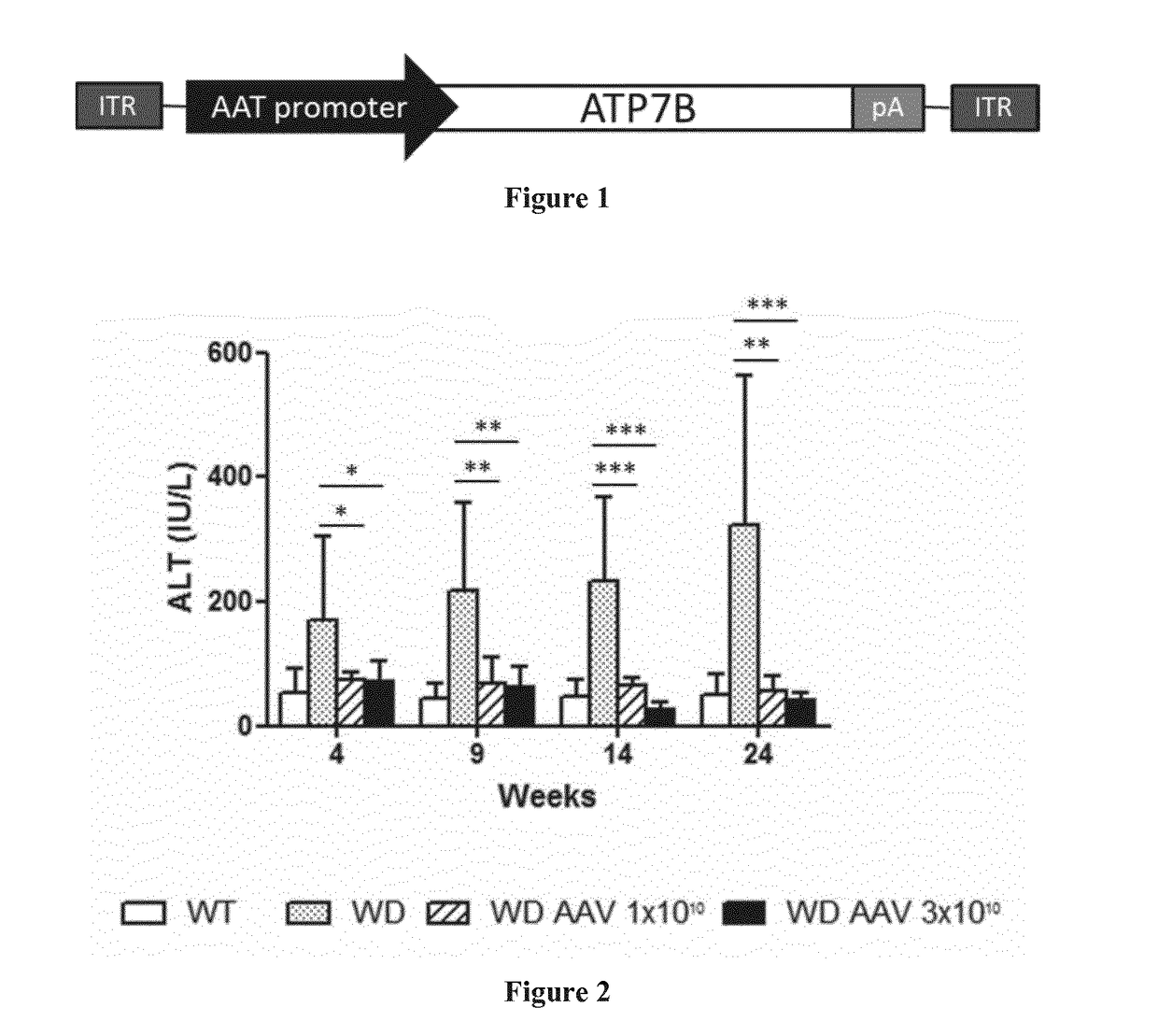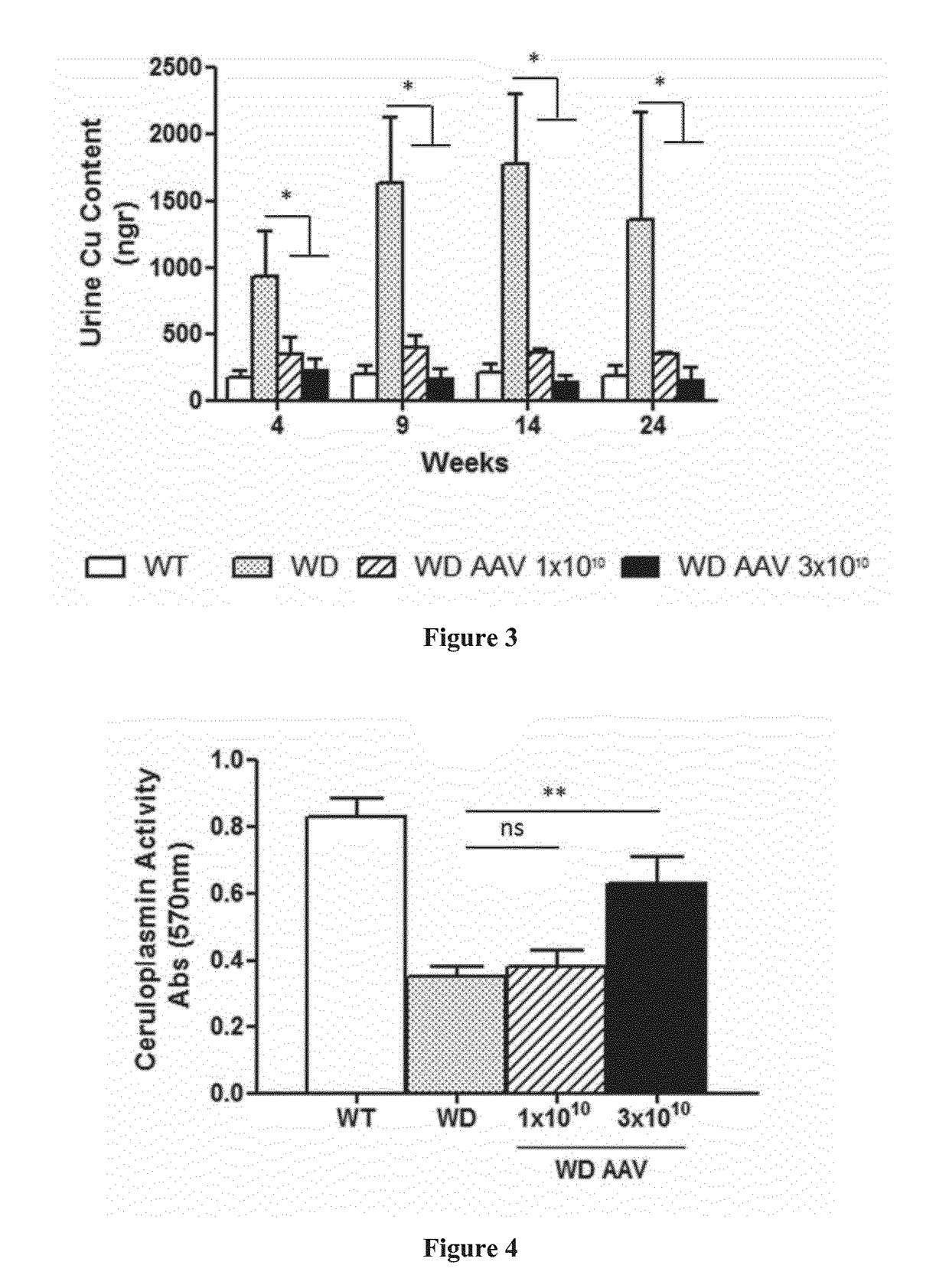Nucleic acid constructs and gene therapy vectors for use in the treatment of wilson's disease and other conditions
a technology of nuclear acid and gene therapy, which is applied in the direction of ssdna viruses, biochemistry apparatus and processes, enzymes, etc., can solve the problems of reducing the hepatocellular excretion of copper into bile, failure to incorporate copper into ceruloplasmin, and mainly in the liver, so as to reduce the inflammatory infiltrate, and restore physiological biliary copper excretion.
- Summary
- Abstract
- Description
- Claims
- Application Information
AI Technical Summary
Benefits of technology
Problems solved by technology
Method used
Image
Examples
example 1
ion of Recombinant Expression Vectors
[0154]Two different AAV vectors that carry and express human ATP7B were designed and produced for gene therapy of Wilson's Disease (WD): AAV2 / 8-AAT-wtATP7B and AAV2 / 8-AAT-coATP7B.
1.1 Vector AAV2 / 8-AAT-wtATP7B
[0155]Firstly, the plasmid pUC-ATP7B was assembled at request (GenScript) by cloning nucleic acid construct into a pUC57 plasmid. Nucleic acid construct contained cDNA sequence encoding human ATP7B (transgene) together with a synthetic polyadenylation signal sequence (Levitt N. et al. Genes &Development 1989; 3(7):1019-1025) downstream of the transgene.
[0156]Next, the minimal promoter of alpha1 anti-trypsin gene (AAT) was introduced into the plasmid pUC-ATP7B, upstream the ATP7B gene. The minimal promoter consists on the sequence from nucleotide −261 to nucleotide+44 relative to cap site of the AAT promoter (Kramer M. G. et al. Mol. Therapy 2003; 7(3): 375-385) and contains the tissue-specific element (TSE), required for liver function, and t...
example 2
Disease Animal Model: ATP7B KO
[0164]The therapeutic performance of the vector AAV2 / 8-AAT-wtATP7B was tested in ATP7B knockout mice (ATP7B KO, ATP7B− / − or WD mice) which are a representative animal model of WD. This animal model was developed by Buiakova et al., by introducing an early termination codon in the mouse ATP7B mRNA by engineering the substitution of a portion of ATP7B exon 2 with a neomycin cassette oriented in the opposite transcriptional frame (Buikova O. I. et al. Human Molecular Genetics 1999; 8(9): 1665-1671). ATP7B knockout mice show no ATP7B expression in the liver and high Cu excretion in the urine, low holoceruloplasmin levels in serum, high transaminase levels, high Cu concentration in the liver and a pathologic liver histology. These mice exhibit the typical biochemical characteristics of human Wilson's disease except for the neurological affectation (Lutsenko S. Biochemical Society Transactions 2008; 36(Pt 6): 1233-1238).
example 3
ic Effect of Viral Vector AAV2 / 8-AAT-wtATP7B in Wilson's Disease Mice
[0165]Six weeks (6 w) old male ATP7B− / − mice were divided in 3 groups of 5 mice each: 2 of the groups were treated intravenously with the vector AAV2 / 8-AAT-wtATP7B at two different doses, 1×1010 vg / mouse (vg: viral genomes) and 3×1010 vg / mouse respectively diluted in saline solution; third group was left untreated. An additional group of wild type mice was kept untreated as a control group. Animals were sacrificed twenty-four weeks after vector administration (w30).
[0166]Four weeks after vector administration (w10) and every five weeks up to week 30 (w15, w20, w25, and w30), serum transaminases (ALT) levels, serum ceruloplasmin activity and urine Cu content were determined in all the groups.
[0167]Serum transaminases (ALT) levels were determined by the DGKC method (Roche Diagnostics, Mannheim, Germany) using a Hitachi 747 Clinical Analyzer (Hitachi, Tokyo, Japan).
[0168]Serum ceruloplasmin activity was determined wit...
PUM
 Login to View More
Login to View More Abstract
Description
Claims
Application Information
 Login to View More
Login to View More - R&D
- Intellectual Property
- Life Sciences
- Materials
- Tech Scout
- Unparalleled Data Quality
- Higher Quality Content
- 60% Fewer Hallucinations
Browse by: Latest US Patents, China's latest patents, Technical Efficacy Thesaurus, Application Domain, Technology Topic, Popular Technical Reports.
© 2025 PatSnap. All rights reserved.Legal|Privacy policy|Modern Slavery Act Transparency Statement|Sitemap|About US| Contact US: help@patsnap.com



